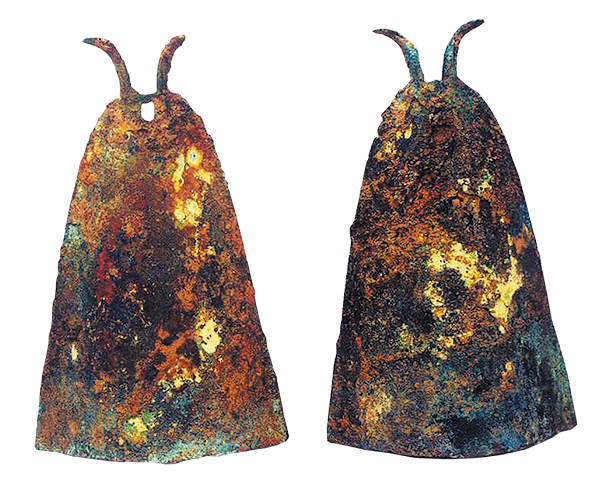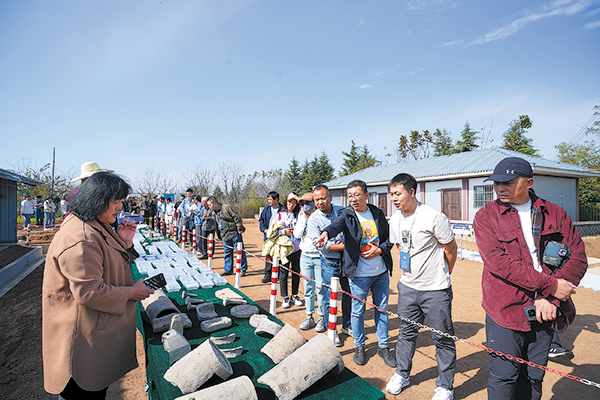2023-11-16 08:01| 发布者: IICC| 查看: 201| 评论: 0
Experts convene at the 4th Congress of Chinese Archaeology to share the latest findings and discoveries, Wang Ru reports in Xi'an.By Wang Ru | China Daily | Updated: 2023-11-16 08:01  In 2021, archaeologists found pottery pieces inscribed with the words bei tian si (Beitian Temple) at the ruins of Beiting city, a political, military and trade center along the ancient Silk Road, in what is now Jimsar county, Xinjiang Uygur autonomous region. The site is where the Beiting Protectorate, an institute established by the Tang Dynasty (618-907) to govern the north of Tianshan Mountain, was located. Archaeologists believe that the pieces are related to a Beitian sanatorium, a place where beggars and disabled people were accommodated and taken care of during the Tang era. The concept of such facilities was initially established in the Tang capitals of Chang'an (now Xi'an, Shaanxi province) and Luoyang during the reign of Empress Wu Zetian from 690 to 705, and later, was gradually promoted across the empire. "The discovery of the pottery pieces implies the establishment of the sanatorium in Beiting at the time," says Hu Tao, a researcher at the Academy of Beiting Studies in Jimsar. "It confirms the consistency of policy implementation between Beiting and the central area of the Tang Dynasty during this period, and shows that, even in the border regions, the decrees of the dynasty were well implemented." The discovery was introduced at a seminar during the 4th Congress of Chinese Archaeology held in Xi'an, Shaanxi province, last month. Organized by the Society for Chinese Archaeology, the Institute of Archaeology at the Chinese Academy of Social Sciences, Shaanxi Provincial Cultural Heritage Administration and the city-level government of Xi'an, the biennial congress was held under the theme of "the formation and development of a unified multiethnic country". More than 800 archaeological professionals at home and abroad participated in the event. Many of them gave reports on the latest academic findings on the theme, and exchanged ideas with each other.  According to Chen Xingcan, director of the Institute of Archaeology, CASS, the congress has been successfully held three times before, with each focusing on a frontier academic issue. Each congress witnesses the latest discoveries and research progress in China's archaeological studies, progress in the comparative studies of ancient civilizations in different regions across the world, and the rising global influence of Chinese civilization, says Chen. During this year's congress, archaeologists say findings offer clues about China's development as a multiethnic country. According to Yang Yong, a researcher at the Institute of Archaeology, CASS, the Qin (221-206 BC) and Han (206 BC-AD 220) dynasties were critical to ancient China's formation and development as a multiethnic country. As a result, it was not accidental that some groups in what is now the southwestern part of the country became part of the Han Dynasty. Archaeological studies of bronze bells unearthed on the Yunnan-Guizhou Plateau dating back to the Han Dynasty show that they mainly consist of two types: one with semicircular suspension loops, and the other with sheep's horn loops. According to Yang, the former was created under the influence of the central region. "The groups living on the plateau are believed to have connected with the music bell culture of the central regions in the later stage of the Warring States Period (475-221 BC), and were influenced by that.  "Probably from the end of the Warring States Period, to the early Western Han Dynasty (206 BC-AD 24), they began to make their own bells with semicircular suspension loops, which imitated the style and use of those from the central regions, but also had their own unique regional features. For example, they are often decorated with animal motifs and geometric patterns that are common to their locale," says Yang. Moreover, people's use of these bronze bells was similar to counterparts used in the Han Dynasty, working as not only musical instruments, but also as part of rituals and as a symbol of social status, he adds. "Although the groups were remote, living on the plateau, the culture, especially bronze culture, had a close link with the Han Dynasty, and was influenced by Han culture. That paved way for the groups to become part of the country," says Yang. Some of the artifacts reflect the "outstanding characteristics of Chinese civilization" as pointed out by President Xi Jinping, namely consistency, originality, uniformity, inclusiveness, and peacefulness, according to Guo Yanli, a professor at the Shaanxi Normal University. She says bronze weapons vividly reflect the originality of Chinese civilization. According to Guo, although there were various types of bronze weapons, yue axes, ge (a long pole with two blades on the end), spears and arrowheads continued to be the major types found from the early period of the Bronze Age to the time before the Qin Dynasty.  A bird's-eye view of the ruins of Beiting city in Jimsar county, Xinjiang Uygur autonomous region.[Photo provided to China Daily] But innovations were made in the development of weapons. People of the Erlitou Culture from the 18th to 16th century BC pioneered the use of bronze weapons in China, which were modeled on those made from stone, marking a milestone in the choice of materials and production techniques. The Shang Dynasty (c. 16th century-11th century BC) was an era for rapid development of bronze weapons. In the late Shang period, with the techniques of making weapons no longer a secret, people in many places started to make weapons by themselves, instead of only relying on supplies from the Shang capital. This is supported by the large number of bronze weapons from that period unearthed at sites in different areas. "During the Zhou Dynasty (c. 11th century-256 BC), the use of bronze weapons became more and more common and widespread, and techniques were improved when people used alloys of iron and bronze, and gold and iron to make weapons. That reflects the creativity of the Zhou people," says Guo. Weapons were often viewed as a symbol of war, and the Chinese people's eagerness for peace can be shown in their habit of destroying weapons. Deliberately broken bronze weapons unearthed from the Erlitou site in Luoyang, Henan province, reveal the phenomenon of destroying weapons at the time. Similar findings have also been made at sites from the Shang and Zhou dynasties.  According to Guo, the habit of destroying weapons can often be seen in ancient tombs, where weapons were deliberately broken, and then put beside the dead to show eagerness for peace. A bronze ge unearthed from a tomb of the Warring States Period in Jingmen, Hubei province, is inscribed with the words dawu bibing, which refer to performing music and dance to express the idea of stopping military affairs and striving for peace. The idea was passed down. The Shiji, or the Records of the Grand Historian, the foundational text of Chinese history dating back to the 1st century BC, notes that after China's first emperor Qinshihuang unified the country in 221 BC, he ordered the collection of weapons and for them to be melted down in Xianyang, the Qin capital. He then cast 12 metal statues to represent the end of war. "Ancient Chinese people attached great importance to military affairs, but combining archaeological discoveries and historical records, we now see that their point was to be careful with them, and reduce them as much as possible," says Guo.
|
 |Archiver|小黑屋|丝路遗产丝绸之路:长安天山廊道的路网
( 陕ICP备07011065号-3 )
|Archiver|小黑屋|丝路遗产丝绸之路:长安天山廊道的路网
( 陕ICP备07011065号-3 )
GMT+8, 2024-7-27 08:01 , Processed in 0.093804 second(s), 20 queries .
Powered by Discuz! X3.5
© 2001-2024 Discuz! Team.





